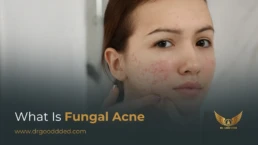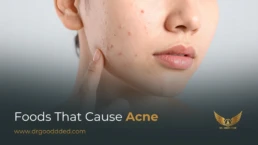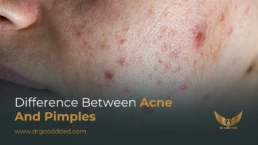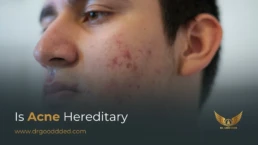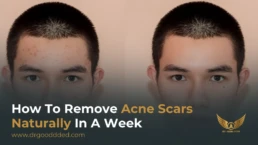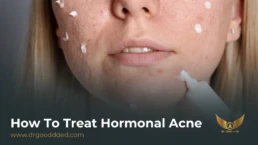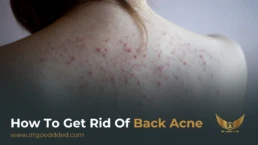Jawline acne is a stubborn breakout that often appears along the lower face and can be painful, red, and hard to treat. Unlike regular pimples, jawline acne usually comes from a mix of hormonal changes, clogged pores, and daily habits. However, it can be controlled and even prevented with the right approach.
Table of Contents
ToggleWhat Is Jawline Acne and Why Does It Happen?
Jawline acne appears along the lower part of your face, especially near the chin and jaw. It can look like whiteheads, blackheads, small bumps, or deep cysts. This type of acne is often hormonal and tends to show up in adults, especially women, even after their teenage years.
Where Jawline Acne Appears and How It Differs from Other Acne Types
Most people get acne on the cheeks, forehead, or back during their teenage years. But jawline acne is more common in adults and usually shows up near the mouth, chin, or neck. The bumps here are often deeper, more painful, and take longer to heal. Unlike surface acne, these cysts form under the skin and can leave dark marks or scars.
The Hormonal Connection — How Androgens and Cortisol Affect Your Skin
Hormones play a major role in causing jawline acne . Androgens (male hormones that both men and women have) increase oil production in your skin. Too much oil mixes with dead cells and clogs pores. Cortisol, a stress hormone, also raises oil levels and inflammation. This is why acne flares up during stress or before your menstrual cycle.
When hormones fluctuate (like during puberty, menstruation, pregnancy, or even after starting or stopping birth control), your skin’s oil glands become overactive. That’s when jawline pimples start forming.
Lifestyle Triggers: Stress, Diet, and Poor Skincare Habits
Stress directly affects hormones, leading to more breakouts. Eating too many sugary or processed foods raises insulin, which increases oil production. Skipping proper face washing, sleeping with makeup on, or using greasy products can worsen acne, too.
People who touch their face often, or pick at pimples, also spread bacteria. Even resting your chin on your hand while scrolling your phone can irritate the area.
Common External Irritants — Masks, Phones, and Makeup
Your phone collects dirt and bacteria throughout the day. When it touches your face, those germs can transfer to your jawline. Tight masks also trap sweat, oil, and heat, creating perfect conditions for acne. Using thick foundations or oily makeup can clog pores further.
If you wear masks often, clean them daily or switch to breathable cotton. Always remove makeup before bed.
Signs You’re Dealing With Jawline Acne
Deep, Tender Bumps or Cysts Along the Jaw and Chin
Jawline acne often appears as deep, painful bumps under the skin. These cysts can last for weeks and may feel sore when touched.
Breakouts That Flare Up Before Menstruation or During Stress
If your acne gets worse before your period or during stressful weeks, hormones are likely the cause. This is why many women see cyclical acne patterns every month.
Persistent Acne That Resists Typical Treatments
If over-the-counter creams and washes don’t help after several weeks, your acne might need stronger, prescription-level care. This kind of acne often doesn’t respond well to basic cleansers or scrubs.
How to Get Rid of Jawline Acne: Step-by-Step Guide
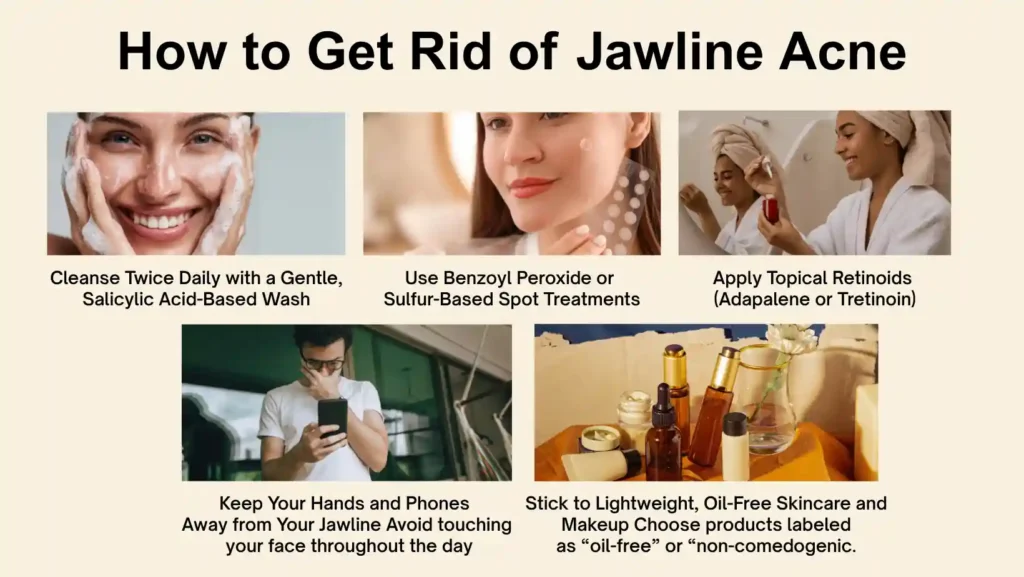
Here’s a step-by-step plan that dermatologists recommend to get rid of jawline acne effectively.
Step 1: Cleanse Twice Daily with a Gentle, Salicylic Acid-Based Wash
Cleansing removes oil, dirt, and bacteria. Use a mild cleanser that contains salicylic acid, which unclogs pores and reduces swelling. Avoid harsh soaps that strip the skin of moisture.
Step 2: Use Benzoyl Peroxide or Sulfur-Based Spot Treatments
Benzoyl peroxide kills acne-causing bacteria. Sulfur helps dry out active pimples. Apply these to the affected areas once a day. Don’t overuse them, as they can cause dryness.
Step 3: Apply Topical Retinoids (Adapalene or Tretinoin) for Cell Turnover
Retinoids increase skin cell renewal, preventing clogged pores. Use them at night after cleansing. They might cause mild peeling at first, which usually improves after two weeks.
Step 4: Keep Your Hands and Phones Away from Your Jawline
Avoid touching your face throughout the day. Clean your phone screen with alcohol wipes. Small daily habits make a big difference in controlling acne.
Step 5: Stick to Lightweight, Oil-Free Skincare and Makeup
Choose products labeled as “oil-free” or “non-comedogenic.” Heavy creams and foundations block pores and worsen acne. Always remove your makeup before bed, even if you’re tired.
Jawline Acne Treatments That Actually Work
If home care doesn’t work, dermatologists have medical solutions that target jawline acne at a deeper level.
Oral Contraceptives for Hormonal Balance
Certain birth control pills regulate hormones, which helps control acne. They lower androgen levels, reducing oil production and flare-ups around the chin and jaw.
Anti-Androgen Medication (Spironolactone)
Spironolactone blocks excess androgens. It’s often prescribed for women who experience hormonal breakouts. It reduces oil buildup and helps prevent new pimples.
Short-Term Oral Antibiotics for Inflammation
Antibiotics like doxycycline or minocycline reduce redness and kill bacteria. They’re used for severe acne but only for short periods to avoid resistance.
Chemical Peels, Blue Light Therapy, or Laser for Acne Scars
If you’re left with dark spots or scars, treatments like chemical peels, laser therapy, or blue light therapy can help. These target bacteria and improve skin texture.
When to See a Dermatologist for Prescription Care
If your acne is painful, cystic, or leaves marks, see a dermatologist. They can prescribe stronger treatments or combine oral and topical options for better results.
How to Get Rid of Jawline Acne Naturally
If you prefer gentle options, you can also explore getting rid of jawline acne naturally with safe home remedies.
Tea Tree Oil and Niacinamide for Anti-Inflammatory Relief
Tea tree oil has antibacterial properties that can reduce swelling and redness. Always dilute it with water before applying. Niacinamide, a form of vitamin B3, soothes irritation and strengthens your skin barrier.
Cut Down on Dairy and High-Glycemic Foods
Research shows that dairy products and foods high in sugar may worsen acne. Choose whole grains, fruits, and vegetables instead. These foods stabilize hormones and reduce oil production.
Green Tea and Omega-3s for Internal Balance
Drinking green tea daily helps lower inflammation and hormonal swings. Omega-3 fatty acids (found in fish, walnuts, and chia seeds) also support clearer skin.
Maintain Hydration and Consistent Sleep Patterns
Drink enough water every day. Lack of sleep and dehydration increase stress hormones, leading to new breakouts.
Your Skincare Routine for Clearer Skin
Gentle Cleanser → Non-Comedogenic Moisturizer → Sunscreen Routine
Morning: Wash with a gentle cleanser, apply a lightweight moisturizer, and always wear sunscreen.
Night: Cleanse again, apply acne treatments, and use retinoids if prescribed.
Avoid Over-Exfoliation or Harsh Scrubs
Scrubbing too hard damages your skin and spreads bacteria. Use chemical exfoliants like salicylic acid once or twice a week instead.
Double-Cleanse if You Wear Makeup or Sunscreen Daily
Use an oil-based cleanser first to remove makeup, then a water-based one to clean your skin. This prevents clogged pores without drying your face.
Consistency Is More Important Than Quick Fixes
Stick to your routine for at least 8–12 weeks. Acne doesn’t clear overnight, but steady care always brings results.
Long-Term Prevention: Keeping Jawline Acne Away
Maintain Hormone Balance Through Stress Control and Regular Exercise
Stress increases cortisol, which triggers acne. Practice yoga, go for walks, or take breaks to relax. Regular exercise helps balance hormones naturally.
Clean Pillowcases, Masks, and Makeup Brushes Weekly
Wash your pillowcases once a week. Clean your makeup brushes and replace mask filters regularly to prevent bacteria buildup.
Manage Diet and Hydration for Stable Oil Production
Drink at least 8 glasses of water daily. Eat foods rich in zinc, vitamin A, and antioxidants to keep your skin healthy.
Schedule Routine Skin Checkups Every Few Months
A dermatologist can track your progress and adjust treatments as needed. This helps prevent scars and relapses.
FAQs
Why Does Acne Mostly Appear on the Jawline?
Acne mostly appears on the jawline due to hormonal changes and clogged pores. This area has more oil glands that react quickly to stress and hormone shifts.
Is Jawline Acne Always Hormonal?
Jawline acne isn’t always hormonal, but hormones play a major role. Skincare habits, diet, and bacteria also contribute to breakouts in this area.
Can Jawline Acne Be Permanently Cured?
While there’s no permanent cure, jawline acne treatment can keep it under control. Following a steady skincare routine and managing hormones helps long-term.
Which Skincare Ingredients Are Best for Jawline Acne?
Salicylic acid, benzoyl peroxide, retinoids, and niacinamide are top ingredients for treating jawline acne. They clean pores, kill bacteria, and balance oil.
What Foods Should I Avoid to Prevent Acne Flare-Ups?
Avoid high-sugar foods, white bread, and dairy if possible. These can trigger hormonal spikes and increase oil production, making acne worse.
How Long Does It Take for Jawline Acne to Clear?
Depending on severity, it may take 8–12 weeks for noticeable results. Consistency with products and avoiding pore-clogging habits are key to jawline acne treatment success.

This article is medically reviewed by Dr. Nivedita Pandey, Senior Gastroenterologist and Hepatologist, ensuring accurate and reliable health information.
Dr. Nivedita Pandey is a U.S.-trained gastroenterologist specializing in pre and post-liver transplant care, as well as managing chronic gastrointestinal disorders. Known for her compassionate and patient-centered approach, Dr. Pandey is dedicated to delivering the highest quality of care to each patient.

